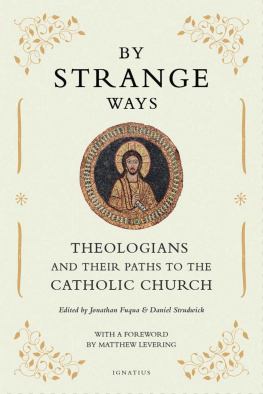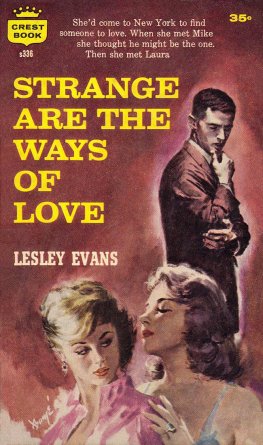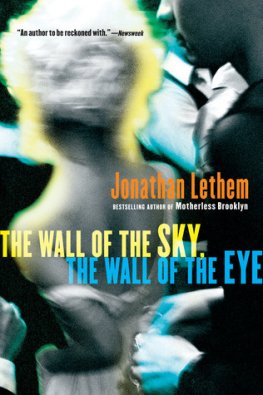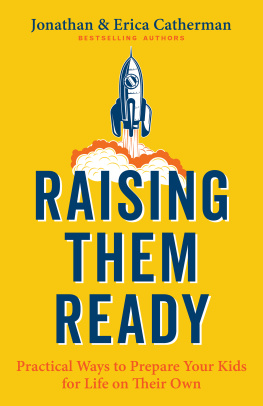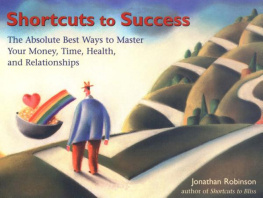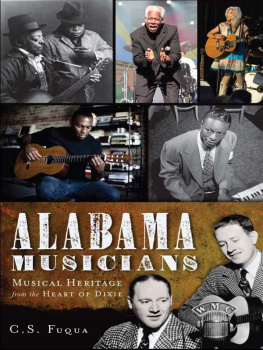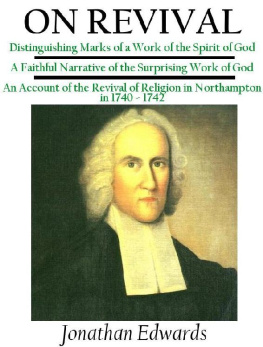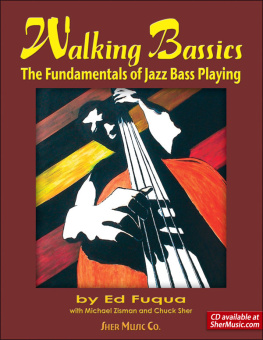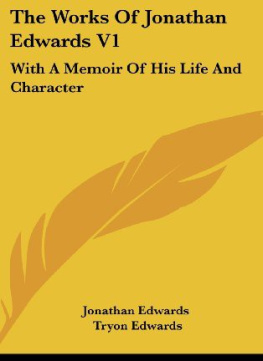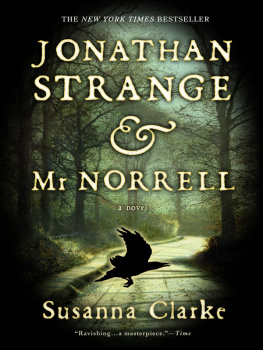Jonathan Fuqua - By Strange Ways
Here you can read online Jonathan Fuqua - By Strange Ways full text of the book (entire story) in english for free. Download pdf and epub, get meaning, cover and reviews about this ebook. year: 2022, publisher: Ignatius Press, genre: Religion. Description of the work, (preface) as well as reviews are available. Best literature library LitArk.com created for fans of good reading and offers a wide selection of genres:
Romance novel
Science fiction
Adventure
Detective
Science
History
Home and family
Prose
Art
Politics
Computer
Non-fiction
Religion
Business
Children
Humor
Choose a favorite category and find really read worthwhile books. Enjoy immersion in the world of imagination, feel the emotions of the characters or learn something new for yourself, make an fascinating discovery.
- Book:By Strange Ways
- Author:
- Publisher:Ignatius Press
- Genre:
- Year:2022
- Rating:4 / 5
- Favourites:Add to favourites
- Your mark:
- 80
- 1
- 2
- 3
- 4
- 5
By Strange Ways: summary, description and annotation
We offer to read an annotation, description, summary or preface (depends on what the author of the book "By Strange Ways" wrote himself). If you haven't found the necessary information about the book — write in the comments, we will try to find it.
By Strange Ways — read online for free the complete book (whole text) full work
Below is the text of the book, divided by pages. System saving the place of the last page read, allows you to conveniently read the book "By Strange Ways" online for free, without having to search again every time where you left off. Put a bookmark, and you can go to the page where you finished reading at any time.
Font size:
Interval:
Bookmark:
BY STRANGE WAYS
Theologians and Their Paths
to the Catholic Church
Edited by
Jonathan Fuqua and Daniel Strudwick
IGNATIUS PRESS SAN FRANCISCO
Unless otherwise indicated, Scripture quotations are from Revised Standard Version of the BibleSecond Catholic Edition (Ignatius Edition) copyright 2006 National Council of the Churches of Christ in the United States of America. All rights reserved worldwide.
Cover photo:
Mosaic of Christ, Pantocrator (detail)
Chapel of San Xeno
Basilica of Santa Prassede, Rome, Italy
Image in the public domain
Cover design by Enrique J. Aguilar
2022 by Ignatius Press, San Francisco
All rights reserved
ISBN 978-1-62164-363-0 (PB)
ISBN 978-1-64229-237-4 (eBook)
Library of Congress Control Number 2022935081
Printed in the United States of America
1 BARNEY ASPRAY
A Greater Hope
2 MELANIE SUSAN BARRETT
From New Age Syncretist to Catholic Moral Theologian
3 LAWRENCE FEINGOLD
The Beauty of Her Varied Face
4 SCOTT HAHN
The Love of Truth and the Truth of Love
5 PAIGE E. DAVIDSON HOCHSCHILD
One Cannot Have Christ without the Church
6 JOSHUA H. LIM
Post tenebras lux : Discovering the Fullness of Truth in the Catholic Faith
7 JEFFREY L. MORROW
The Reluctant Conversion of a Skeptic
8 REV. ANDREW J. SUMMERSON, S.TH.D.
Jonah the Crowd-Surfer Becoming an Exegete of the Byzantine Tradition
9 MATTHEW THOMAS
An Unconversion
10 PETROC WILLEY
Climbing the Wrekin
God knows what is my greatest happiness, but I do not. There is no rule about what is happy and good; what suits one would not suit another. And the ways by which perfection is reached vary very much; the medicines necessary for our souls are very different from each other. Thus God leads us by strange ways; we know He wills our happiness, but we neither know what our happiness is, nor the way. We are blind; left to ourselves we should take the wrong way; we must leave it to Him.
John Henry Newman
by
Matthew Levering
Reading about these Catholic conversions and thinking of my own story of conversion, I recall a time when such things hardly seemed possible. I grew up in the 1970s and early 1980s. Although I was not a Catholic, I had a number of Catholic friends, and the condition of their faith was generally abysmal. Many if not most of the children raised Catholic in my generation have now lapsed. The briefest glance at the 1970s bookshelf tells the tale regarding the struggles of that era: Richard McBriens Do We Need the Church ? and The Remaking of the Church ; Peter Hebblethwaites Faith in Question ; Avery Dulles The Survival of Dogma . The titles reflect the mood of the time.
Since the present volume contains the conversion stories of people who not only are converts but also are theologians , 1970s Catholic theology merits some attention in this foreword. McBriens The Remaking of the Church was dedicated to Richard Cardinal Cushing and bore a preface by Leo Cardinal Suenens. In this book published only four years after the Second Vatican Council, McBrien asks: Is there a point any longer to making proposals for institutional change within an organization [the Catholic Church!] whose long-term viability has been placed in fundamental question? He calls for a massive reform, and he warns ominously about the resistance of the entrenched powers-that-be in the Vatican and elsewhere. Similar insistence that the Church must be entirely remade, and similar dire warnings about entrenched resistance to overthrowing fundamental teachings of Vatican IIs own Dogmatic Constitution on the Church, Lumen Gentium , are everywhere among McBriens fellow theologians after the council.
Much of the theological malaise of the era is summed up in Hans Kngs Signposts for the Future , a collection of essays written in the late 1960s and early 1970s. After proclaiming the good news that Jesus is alive, Kng goes on to explain that the first believers regarded their faith as based on something that really happened to them, insofar as they were now sustained, impelled, by the certainty that the man who was killed did not remain dead but is alive. He contends that at the Resurrection of Jesus, there was no revival of a corpse. What then happened to the corpse? He does not say, but instead he offers the view that Jesus, having died, was assumed into that incomprehensible and comprehensive last and first reality, by that most real reality which we designate with the name of God.
Not surprisingly, such a less-than-robust account of Jesus Resurrection fuels reductive understandings of the Church. In the 1970s and early 1980s, Karl Rahner proposed immediately uniting with the Protestants in order to form a new umbrella Church, unified by shared belief in Christ and the Trinity. Rahner deems that in the new unified Church, all partner churches must solely agree not to condemn the distinctive beliefs of the other partner churches. He thinks this should be enough to ground full fellowship in Eucharistic communion and in ministry (whatever either would now mean)with the pope as a figurehead, lacking authority to do anything other than to confirm the results of any future general councils of the partner churches. It follows for Rahner that we cannot know today what Catholics will believe in the future, even if Catholic belief, he thinks, will retain a connection to Christ and the Trinity.
This was not exactly the heyday among Catholics of Saint John Henry Newmans dogmatic principle and sacramental principle. No wonder that the Yale professor Anthony Kronman began a lifelong process of conversion during the 1960s and 1970s, but to paganism rather than to Catholicism! In his Confessions of a Born-Again Pagan surely a fitting mantra for the 1970s if there ever was oneKronman discusses Augustine and Thomas Aquinas but takes the seventeenth-century skeptic Benedict Spinoza as his mentor and model, in arguing that the world is both inherently and infinitely divine. The divine, then, is nothing other than the unfolding cosmos, with its explosions, destruction, and (on Earth) death. He concludes on page 1074 that death is final, but that we will always be part of eternity because the worldrldhe cosmos of which we are a part and always will be a part, materially speakingis the immortal divine being. Some consolation!
Looking back on it, Catholicism in the 1970s seemed to be trying to convert to the worldand a dreary world at that. It is in this context that the conversions recorded in the present book should call us to rejoice, both in their fruitfulness and due to the amazing recovery executed by the Church in the final two decades of the twentieth century. As Newman remarks, It is true, there have been seasons when, from the operation of external or internal causes, the Church has been thrown into what was almost a state of deliquium ; but her wonderful revivals, while the world was triumphing over her, is a further evidence of the absence of corruption in the system of doctrine and worship into which she has developed. In the fervid postconciliar years, the Catholic faith did not succeed in self-imploding, despite all the urgent demands that it do so, and despite all the requiems for the faith (many offered by theologians themselves!). Where sin increased, grace abounded all the more (Rom 5:20). Under the pontificates of Saint John Paul II and Benedict XVI, the contributors to this volume joyfully became Catholics. Many other theologians did as well: Thomas Joseph White, O.P., John Betz, Reinhard Htter, Stephen Bullivant, Bruce Marshall, R. R. Reno, Richard John Neuhaus, and many, many more. In this extraordinary volume, we receive a taste of how this happened and why.
My colleague Melanie Barretts conversion journey in the 1990s took her from a secular Jewish upbringing influenced by New Age spirituality, to a doctoral program at the University of Chicago under the mentorship of Jean Bethke Elshstain, to friendship with Francis Cardinal George and then-Father Robert Barron and a profound commitment to the Catholic moral life. Similarly, Lawrence Feingold began as a nonpracticing Jewish sculptor in Romea very talented sculptor, indeed. In Rome during the 1990s, Larry became a Catholic and wrote a doctoral dissertation launching an entirely new discussion of nature and grace that has continued to the present day. Jeff Morrow was a third convert from secular Judaism, who became a keen critic of Spinoza and who has greatly expanded our understanding of the earliest historical-critical scholars of Scripture.
Next pageFont size:
Interval:
Bookmark:
Similar books «By Strange Ways»
Look at similar books to By Strange Ways. We have selected literature similar in name and meaning in the hope of providing readers with more options to find new, interesting, not yet read works.
Discussion, reviews of the book By Strange Ways and just readers' own opinions. Leave your comments, write what you think about the work, its meaning or the main characters. Specify what exactly you liked and what you didn't like, and why you think so.

